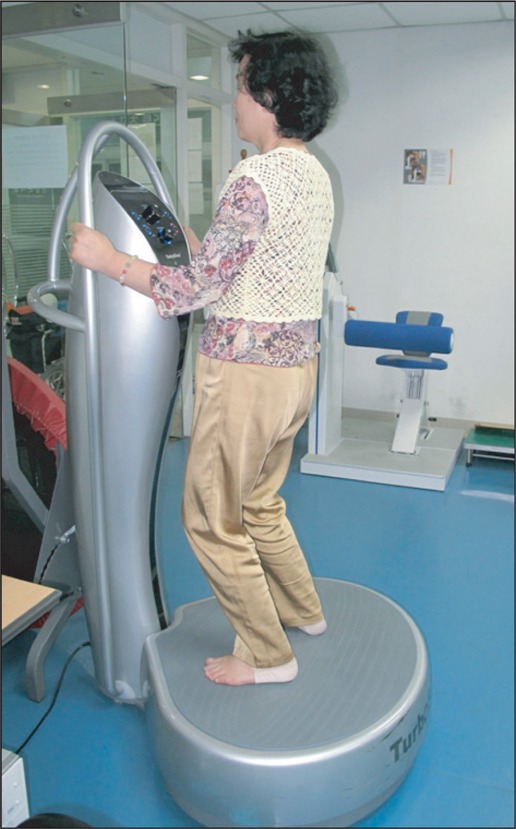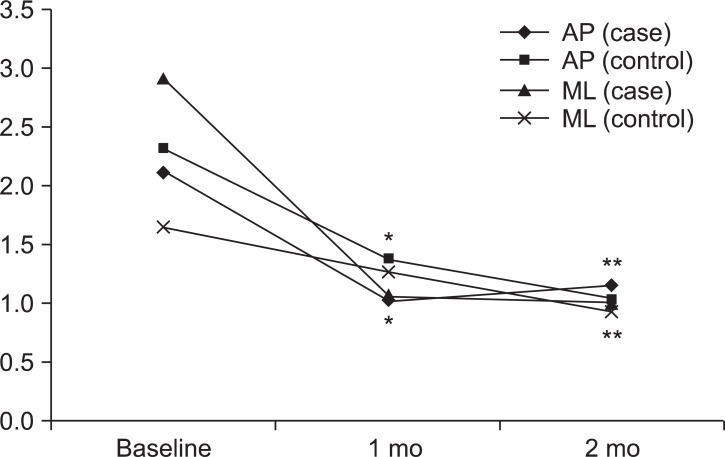Ann Rehabil Med.
2013 Aug;37(4):505-515. 10.5535/arm.2013.37.4.505.
Therapeutic Effect of Whole Body Vibration on Chronic Knee Osteoarthritis
- Affiliations
-
- 1Department of Physical Medicine and Rehabilitation, Dongguk University College of Medicine, Goyang, Korea. hjrhee1@dumc.or.kr
- KMID: 2266606
- DOI: http://doi.org/10.5535/arm.2013.37.4.505
Abstract
OBJECTIVE
To investigate the effect on pain reduction and strengthening of the whole body vibration (WBV) in chronic knee osteoarthritis (OA).
METHODS
Patients were randomly divided into two groups: the study group (WBV with home based exercise) and control group (home based exercise only). They performed exercise and training for 8 weeks. Eleven patients in each group completed the study. Pain intensity was measured with the Numeric Rating Scale (NRS), functional scales were measured with Korean Western Ontario McMaster score (KWOMAC) and Lysholm Scoring Scale (LSS), quadriceps strength was measured with isokinetic torque and isometric torque and dynamic balance was measured with the Biodex Stability System. These measurements were performed before training, at 1 month after training and at 2 months after training.
RESULTS
NRS was significantly decreased in each group, and change of pain intensity was significantly larger in the study group than in the control group after treatment. Functional improvements in KWOMAC and LSS were found in both groups, but no significant differences between the groups after treatment. Dynamic balance, isokinetic strength of right quadriceps and isometric strengths of both quadriceps muscles improved in both groups, but no significant differences between the groups after treatment. Isokinetic strength of left quadriceps did not improve in both groups after treatment.
CONCLUSION
In chronic knee OA patients, WBV reduced pain intensity and increased strength of the right quadriceps and dynamic balance performance. In comparison with the home based exercise program, WBV was superior only in pain reduction and similarly effective in strengthening of the quadriceps muscle and balance improvement.
Keyword
MeSH Terms
Figure
Reference
-
1. Dillon CF, Rasch EK, Gu Q, Hirsch R. Prevalence of knee osteoarthritis in the United States: arthritis data from the Third National Health and Nutrition Examination Survey 1991-94. J Rheumatol. 2006; 33:2271–2279. PMID: 17013996.2. Hochberg MC, Altman RD, April KT, Benkhalti M, Guyatt G, McGowan J, et al. American College of Rheumatology 2012 recommendations for the use of nonpharmacologic and pharmacologic therapies in osteoarthritis of the hand, hip, and knee. Arthritis Care Res (Hoboken). 2012; 64:465–474. PMID: 22563589.
Article3. Iwamoto J, Takeda T, Sato Y. Effect of muscle strengthening exercises on the muscle strength in patients with osteoarthritis of the knee. Knee. 2007; 14:224–230. PMID: 17395467.
Article4. Devos-Comby L, Cronan T, Roesch SC. Do exercise and self-management interventions benefit patients with osteoarthritis of the knee? A metaanalytic review. J Rheumatol. 2006; 33:744–756. PMID: 16583478.5. Tan J, Balci N, Sepici V, Gener FA. Isokinetic and isometric strength in osteoarthrosis of the knee: a comparative study with healthy women. Am J Phys Med Rehabil. 1995; 74:364–369. PMID: 7576413.6. Hootman JM, FitzGerald SJ, Macera CA, Blair SN. Lower extremity muscle strength and risk of self-reported hip or knee osteoarthritis. J Phys Act Health. 2004; 1:321–330.
Article7. McAlindon TE, Cooper C, Kirwan JR, Dieppe PA. Determinants of disability in osteoarthritis of the knee. Ann Rheum Dis. 1993; 52:258–262. PMID: 8484690.
Article8. Kirkley A, Webster-Bogaert S, Litchfield R, Amendola A, MacDonald S, McCalden R, et al. The effect of bracing on varus gonarthrosis. J Bone Joint Surg Am. 1999; 81:539–548. PMID: 10225800.
Article9. Barrett DS, Cobb AG, Bentley G. Joint proprioception in normal, osteoarthritic and replaced knees. J Bone Joint Surg Br. 1991; 73:53–56. PMID: 1991775.
Article10. Cochrane DJ, Stannard SR. Acute whole body vibration training increases vertical jump and flexibility performance in elite female field hockey players. Br J Sports Med. 2005; 39:860–865. PMID: 16244199.
Article11. Bogaerts A, Verschueren S, Delecluse C, Claessens AL, Boonen S. Effects of whole body vibration training on postural control in older individuals: a 1 year randomized controlled trial. Gait Posture. 2007; 26:309–316. PMID: 17074485.
Article12. Fagnani F, Giombini A, Di Cesare A, Pigozzi F, Di Salvo V. The effects of a whole-body vibration program on muscle performance and flexibility in female athletes. Am J Phys Med Rehabil. 2006; 85:956–962. PMID: 17117001.
Article13. Cardinale M, Bosco C. The use of vibration as an exercise intervention. Exerc Sport Sci Rev. 2003; 31:3–7. PMID: 12562163.
Article14. Cardinale M, Lim J. The acute effects of two different whole body vibration frequencies on vertical jump performance. Med Sport. 2003; 56:287–292.15. Trans T, Aaboe J, Henriksen M, Christensen R, Bliddal H, Lund H. Effect of whole body vibration exercise on muscle strength and proprioception in females with knee osteoarthritis. Knee. 2009; 16:256–261. PMID: 19147365.
Article16. Kellgren JH, Lawrence JS. Radiological assessment of osteo-arthrosis. Ann Rheum Dis. 1957; 16:494–502. PMID: 13498604.
Article17. Fitzgerald GK, Oatis C. Role of physical therapy in management of knee osteoarthritis. Curr Opin Rheumatol. 2004; 16:143–147. PMID: 14770101.
Article18. Bae SC, Lee HS, Yun HR, Kim TH, Yoo DH, Kim SY. Cross-cultural adaptation and validation of Korean Western Ontario and McMaster Universities (WOMAC) and Lequesne osteoarthritis indices for clinical research. Osteoarthritis Cartilage. 2001; 9:746–750. PMID: 11795994.
Article19. Bosco C, Cardinale M, Tsarpela O, Colli R, Tihanyi J, von Duvillard SP, et al. The influence of whole body vibration on jumping ability. Biol Sport. 1998; 15:157–164.20. Bosco C, Colli R, Introini E, Cardinale M, Tsarpela O, Madella A, et al. Adaptive responses of human skeletal muscle to vibration exposure. Clin Physiol. 1999; 19:183–187. PMID: 10200901.
Article21. Torvinen S, Kannu P, Sievanen H, Jarvinen TA, Pasanen M, Kontulainen S, et al. Effect of a vibration exposure on muscular performance and body balance: randomized cross-over study. Clin Physiol Funct Imaging. 2002; 22:145–152. PMID: 12005157.
Article22. Nigg BM. Impact forces in running. Curr Opin Orthop. 1997; 8:43–47.
Article23. De Gail P, Lance JW, Neilson PD. Differential effects on tonic and phasic reflex mechanisms produced by vibration of muscles in man. J Neurol Neurosurg Psychiatry. 1966; 29:1–11. PMID: 5910574.
Article24. Issurin VB, Liebermann DG, Tenenbaum G. Effect of vibratory stimulation training on maximal force and flexibility. J Sports Sci. 1994; 12:561–566. PMID: 7853452.
Article25. Lundstrom RJ. Responses of mechanoreceptive afferent units in the glabrous skin of the human hand to vibration. Scand J Work Environ Health. 1986; 12(4 Spec No):413–416. PMID: 3775331.
Article26. Talbot WH, Darian-Smith I, Kornhuber HH, Mountcastle VB. The sense of flutter-vibration: comparison of the human capacity with response patterns of mechanoreceptive afferents from the monkey hand. J Neurophysiol. 1968; 31:301–334. PMID: 4972033.
Article27. Bensmaia SJ, Leung YY, Hsiao SS, Johnson KO. Vibratory adaptation of cutaneous mechanoreceptive afferents. J Neurophysiol. 2005; 94:3023–3036. PMID: 16014802.28. Leung YY, Bensmaia SJ, Hsiao SS, Johnson KO. Time-course of vibratory adaptation and recovery in cutaneous mechanoreceptive afferents. J Neurophysiol. 2005; 94:3037–3045. PMID: 16222071.
Article29. Hollins M, Roy EA. Perceived intensity of vibrotactile stimuli: the role of mechanoreceptive channels. Somatosens Mot Res. 1996; 13:273–286. PMID: 9110430.
Article30. Ford KR, Myer GD, Hewett TE. Valgus knee motion during landing in high school female and male basketball players. Med Sci Sports Exerc. 2003; 35:1745–1750. PMID: 14523314.
Article31. Hewett TE, Myer GD, Ford KR. Prevention of anterior cruciate ligament injuries. Curr Womens Health Rep. 2001; 1:218–224. PMID: 12112973.32. Knapik JJ, Bauman CL, Jones BH, Harris JM, Vaughan L. Preseason strength and flexibility imbalances associated with athletic injuries in female collegiate athletes. Am J Sports Med. 1991; 19:76–81. PMID: 2008935.
Article33. Thomas KS, Muir KR, Doherty M, Jones AC, O'Reilly SC, Bassey EJ. Home based exercise programme for knee pain and knee osteoarthritis: randomised controlled trial. BMJ. 2002; 325:752. PMID: 12364304.
Article34. Ben Salah Frih Z, Fendri Y, Jellad A, Boudoukhane S, Rejeb N. Efficacy and treatment compliance of a home-based rehabilitation programme for chronic low back pain: a randomized, controlled study. Ann Phys Rehabil Med. 2009; 52:485–496. PMID: 19473905.35. Kawasaki T, Kurosawa H, Ikeda H, Takazawa Y, Ishijima M, Kubota M, et al. Therapeutic home exercise versus intraarticular hyaluronate injection for osteoarthritis of the knee: 6-month prospective randomized open-labeled trial. J Orthop Sci. 2009; 14:182–191. PMID: 19337810.
Article36. Seidel H, Heide R. Long-term effects of whole-body vibration: a critical survey of the literature. Int Arch Occup Environ Health. 1986; 58:1–26. PMID: 3522434.
Article37. Dupuis H, Zerlett G. Whole-body vibration and disorders of the spine. Int Arch Occup Environ Health. 1987; 59:323–336. PMID: 3497111.
Article38. Hulshof C, van Zanten BV. Whole-body vibration and low-back pain: a review of epidemiologic studies. Int Arch Occup Environ Health. 1987; 59:205–220. PMID: 2952598.
- Full Text Links
- Actions
-
Cited
- CITED
-
- Close
- Share
- Similar articles
-
- The Effect of Closed-Needle Irrigation of Knee in Patients with Osteoarthritis
- Effects of Therapeutic Exercise on Patients with Osteoarthritis of Knee
- Arthroscopic Treatment for Osteoarthritic Knee
- High Tibial Osteotomy for Medial Knee Osteoarthritis
- Arthroscopic debridement in osteoarthritis of the knee





